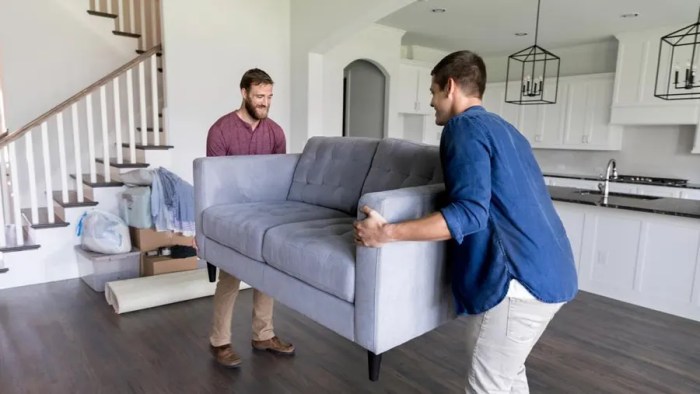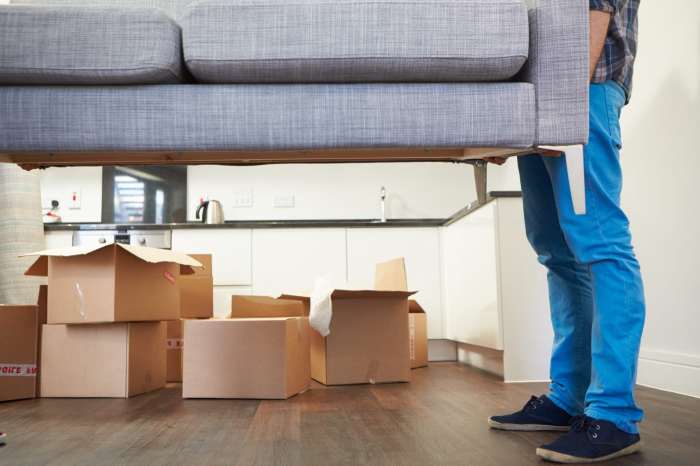Embark on a furniture move journey that unravels the secrets of seamless relocation. From packing and protection to transportation and arrangement, this guide will equip you with the knowledge and strategies to navigate the complexities of moving your prized possessions.
Delve into the intricacies of furniture moving services, discover the art of packing and unpacking, and explore innovative techniques for furniture protection. We’ll uncover the secrets of loading and unloading, transportation, and insurance, empowering you to make informed decisions throughout the process.
Furniture Moving Services
Furniture moving services are designed to assist individuals and businesses with the relocation of their furniture and other household items. These services offer a range of options to meet diverse needs and budgets.
When choosing a furniture moving service, several factors should be considered, including the size of the move, the distance of the move, the availability of packing and unpacking services, and the level of insurance coverage provided.
Getting Quotes and Comparing Prices
To ensure competitive pricing, it is advisable to obtain quotes from multiple furniture moving companies. This can be done by contacting the companies directly, visiting their websites, or using online quote comparison platforms.
When comparing quotes, it is important to consider the following:
- The total cost of the move, including any additional fees or charges.
- The estimated time of arrival and departure.
- The level of insurance coverage provided.
- The availability of packing and unpacking services.
Packing and Unpacking

Proper packing is crucial for successful furniture moves. It protects your belongings from damage during transit and makes unpacking easier.
Packing furniture yourself requires careful planning and attention to detail. Start by gathering necessary materials such as sturdy boxes, packing paper, bubble wrap, and packing tape. Disassemble furniture when possible, and wrap individual pieces securely to prevent scratches or dents.
Packing Different Types of Furniture
- Upholstered furniture:Remove cushions and wrap them separately. Cover the frame with plastic wrap or a furniture cover.
- Wooden furniture:Wrap each piece in packing paper and secure with tape. Use bubble wrap for delicate areas or carvings.
- Glass furniture:Use multiple layers of bubble wrap and pack in sturdy boxes with plenty of cushioning.
- Appliances:Unplug and clean appliances. Wrap cords securely and pack in original boxes or padded containers.
Hiring professional packers and unpackers offers several benefits. They have the expertise and equipment to pack your belongings safely and efficiently, saving you time and effort. They can also provide specialized packing materials and insurance for your peace of mind.
Furniture Protection
Protecting furniture during a move is crucial to prevent damage and maintain its condition. Various methods are employed to safeguard furniture items, each with its advantages and disadvantages.
Moving furniture can be a daunting task, especially if you’re moving to another state. If you’re looking for guidance on how to ship furniture to another state, check out this informative article: How to Ship Furniture to Another State . This comprehensive guide will provide you with valuable tips and insights to ensure a smooth and successful furniture move.
Furniture Blankets
Furniture blankets are thick, padded covers designed specifically for protecting furniture during moves. They provide excellent cushioning and protection against scratches, dents, and impacts. However, they can be bulky and time-consuming to use, especially for larger items.
Moving furniture can be a daunting task, but it doesn’t have to be. A furniture shipping company can take care of all the heavy lifting and transportation for you, making your move a breeze. They have the experience and expertise to pack and ship your furniture safely and securely, so you can rest assured that your belongings will arrive at your new home in one piece.
Plastic Wrap
Plastic wrap is a versatile and inexpensive option for furniture protection. It creates a moisture barrier, preventing dust, dirt, and water damage. However, it offers limited cushioning and can tear easily, leaving furniture vulnerable to scratches and dents.
Cardboard Boxes
Cardboard boxes provide a sturdy and economical way to protect smaller furniture items, such as lamps, electronics, and artwork. They offer good cushioning and can be easily customized to fit different shapes and sizes. However, they are not as durable as furniture blankets and can be easily crushed if not handled carefully.
Tips for Protecting Fragile and Valuable Furniture
* Use multiple layers of protection, such as a furniture blanket wrapped in plastic wrap.
- Disassemble furniture into smaller pieces for easier handling and protection.
- Secure loose parts, such as knobs and handles, with tape or bubble wrap.
- Place fragile items in the center of boxes and surround them with soft materials, such as packing peanuts or towels.
- Label boxes clearly to indicate their contents and ensure careful handling.
Loading and Unloading
The loading and unloading of furniture require meticulous care and expertise to ensure the safe and efficient movement of your belongings. Proper techniques, equipment, and manpower are crucial to prevent damage during these critical stages of the moving process.
Techniques for Safe Loading and Unloading
- Disassemble Furniture:When possible, disassemble large or complex furniture items into smaller, manageable pieces. This reduces the risk of damage and makes handling easier.
- Use Moving Blankets:Wrap furniture in thick moving blankets to protect surfaces from scratches and dents. Secure blankets with packing tape to prevent them from slipping.
- Use Proper Lifting Techniques:Lift furniture using your legs, not your back. Bend your knees and keep your back straight. Carry heavy items with a partner or use lifting straps.
- Use Dollies and Sliders:Dollies and sliders make it easier to move heavy furniture across floors without causing damage. Place dollies under the base of furniture and use sliders on legs to reduce friction.
Importance of Proper Equipment and Manpower
Using the right equipment and having sufficient manpower is essential for safe and efficient loading and unloading. This includes:
- Moving Truck:Choose a moving truck that is the appropriate size for your furniture. Ensure it has a ramp or liftgate for easy loading and unloading.
- Moving Blankets:Have plenty of thick moving blankets to protect furniture surfaces.
- Packing Tape:Secure moving blankets and protect furniture edges with packing tape.
- Dollies and Sliders:Use dollies to move heavy furniture and sliders to reduce friction on floors.
- Lifting Straps:Use lifting straps for heavy or awkward items to prevent back injuries.
- Sufficient Manpower:Have enough people to assist with loading and unloading, especially for heavy or bulky items.
Tips for Avoiding Damage
- Inspect Furniture Before Loading:Check furniture for any existing damage before loading. Note any scratches or dents and document them for insurance purposes.
- Use Padding and Corner Protectors:Place padding or corner protectors on sharp edges and corners of furniture to prevent damage during loading and unloading.
- Secure Furniture in Moving Truck:Use straps or bungee cords to secure furniture in the moving truck to prevent it from shifting during transit.
- Unload Furniture Carefully:Unload furniture in the same careful manner as loading. Use lifting techniques, dollies, and sliders to avoid damage.
Transportation
Moving furniture requires careful planning and execution, and transportation is a crucial aspect of the process. Choosing the right moving vehicle and securing furniture properly during transit are essential for ensuring a smooth and damage-free move.
Types of Vehicles
The type of vehicle used for a furniture move depends on the size and quantity of items being transported. Common options include:
- Small moving trucks:Suitable for small moves involving a few pieces of furniture and personal belongings.
- Medium moving trucks:Can accommodate larger furniture items and multiple boxes.
- Large moving trucks:Designed for extensive moves involving large furniture, appliances, and multiple rooms.
- Moving vans:Provide additional space and protection for valuable or fragile items.
Choosing a Moving Vehicle
When selecting a moving vehicle, consider the following factors:
- Size of the move:Estimate the volume of furniture and belongings to determine the appropriate vehicle size.
- Distance of the move:Longer distances may require a larger vehicle with more space for packing materials.
- Accessibility of the loading and unloading locations:Narrow streets or limited parking may require a smaller vehicle.
- Budget:Moving truck rental costs vary based on size and availability.
Securing Furniture in the Moving Vehicle
To prevent damage during transit, it is essential to secure furniture properly in the moving vehicle:
- Use moving blankets:Wrap furniture in blankets to protect it from scratches and dents.
- Secure with straps:Use ratchet straps or tie-downs to secure furniture to the walls of the vehicle.
- Fill empty spaces:Fill any gaps between furniture items with packing paper or foam to prevent shifting.
- Use furniture pads:Place furniture pads under heavy items to distribute weight and prevent damage to the vehicle’s floor.
- Load heavy items first:Place heavier furniture items at the bottom of the vehicle for stability.
Insurance and Liability

When it comes to furniture moving, it’s crucial to have adequate insurance coverage to protect your belongings against potential damage or loss during the move. Furniture moving insurance provides financial protection in the event of unforeseen circumstances, ensuring peace of mind throughout the process.
Moving furniture can be a daunting task, especially when it involves moving it to another state. Fortunately, there are ways to do it on a budget. One of the most cost-effective options is to consider the cheapest way to move furniture to another state . By exploring various options and seeking professional advice, you can find a solution that suits your specific needs and budget, making the furniture move less stressful and more manageable.
There are various types of insurance coverage available for furniture moving, each with its own set of benefits and limitations. It’s essential to understand the different options to determine the coverage that best suits your needs and budget.
Insurance Coverage Options
- Basic Coverage:This coverage typically includes protection against damage or loss caused by accidents, such as collisions or overturns during transportation.
- Comprehensive Coverage:This coverage offers more extensive protection than basic coverage, including coverage for damage or loss due to natural disasters, theft, or vandalism.
- Valuation Coverage:This coverage provides compensation based on the actual cash value of your belongings at the time of the loss, up to a specified limit.
- Replacement Cost Coverage:This coverage provides compensation based on the cost of replacing your belongings with new items of comparable quality, up to a specified limit.
Filing a Claim
In the unfortunate event that damage or loss occurs during your move, it’s important to follow these steps to file a claim:
- Report the damage or loss promptly:Notify your insurance company within the time frame specified in your policy, usually within 24 to 48 hours.
- Document the damage or loss:Take photos or videos of the damaged items and provide a detailed description of the loss.
- Provide supporting documentation:Submit any relevant documentation, such as receipts, estimates, or appraisals, to support your claim.
- Cooperate with the insurance adjuster:The insurance adjuster will investigate the claim and determine the extent of the coverage.
Furniture Arrangement: Furniture Move
Furniture arrangement plays a crucial role in creating a functional and visually appealing space. By following the principles of design and utilizing space planning techniques, you can transform your rooms into comfortable and inviting environments.
Room-Specific Principles
The arrangement of furniture should complement the purpose and dimensions of each room. For example, in living rooms, seating areas should be arranged around focal points like fireplaces or entertainment systems to facilitate conversation and create a cozy atmosphere. In bedrooms, the bed should be the focal point, with other furniture pieces placed around it to maximize space and create a relaxing sanctuary.
Creating a Functional Layout
When arranging furniture, prioritize functionality. Ensure there is ample space for movement and that furniture pieces are placed conveniently for daily use. Consider the traffic flow and natural light sources in the room. Avoid overcrowding or blocking pathways, as this can hinder accessibility and make the space feel cluttered.
Space Planning Techniques, Furniture move
Various space planning tools and techniques can help you visualize and optimize furniture arrangements. Floor plans, scale drawings, and furniture templates allow you to experiment with different layouts before moving any furniture. Additionally, using painter’s tape or cardboard cutouts can help you test arrangements without making permanent changes.
Ending Remarks

As you embark on your furniture move, remember the principles Artikeld in this guide. With meticulous planning, careful execution, and a touch of ingenuity, you can transform your relocation into a seamless and stress-free experience. May your new abode embrace your cherished belongings, creating a haven of comfort and memories.
FAQ Compilation
What are the benefits of hiring professional furniture movers?
Professional movers provide expertise, efficiency, and peace of mind. They handle heavy lifting, ensure safe packing and transportation, and minimize the risk of damage.
How can I protect fragile furniture items during a move?
Use specialized packing materials such as bubble wrap, foam peanuts, and furniture blankets. Double-box fragile items and label them clearly. Consider hiring professional packers for added protection.
What is the importance of furniture moving insurance?
Furniture moving insurance provides financial protection in case of damage or loss during transit. It covers the cost of repairs or replacements, giving you peace of mind and safeguarding your valuable belongings.